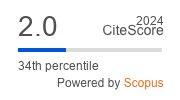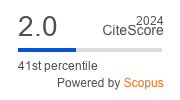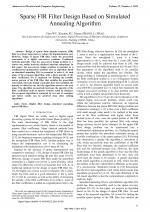| 1/2015 - 3 |
Sparse FIR Filter Design Based on Simulated Annealing AlgorithmWU, C. |
| Extra paper information in |
| Click to see author's profile in |
| Download PDF |
Author keywords
digital filter design, simulated annealing, sparse FIR filter
References keywords
design(12), signal(10), processing(10), filters(10), systems(8), sparse(8), response(7), filter(7), circuits(7), simulated(6)
Blue keywords are present in both the references section and the paper title.
About this article
Date of Publication: 2015-02-28
Volume 15, Issue 1, Year 2015, On page(s): 17 - 22
ISSN: 1582-7445, e-ISSN: 1844-7600
Digital Object Identifier: 10.4316/AECE.2015.01003
Web of Science Accession Number: 000352158600003
SCOPUS ID: 84924766096
Abstract
Design of sparse finite impulse response (FIR) filter is of great importance to reduce the implementation cost. However, design of sparse FIR filter under the prescribed constraints is a highly non-convex problem. Traditional methods generally relax the non-convex design problem to a convex one, which leads the obtained solutions suboptimal. In this paper, the non-convex design problem is modeled as a combinatorial optimization problem and an algorithm based on simulated annealing (SA) is presented to solve it. At each stage of the proposed algorithm, with a fixed sparsity of the filter coefficients, SA is employed for finding the possible sparse pattern of the FIR filter that satisfies the prescribed constraints. Once the design constraints have been satisfied, the sparsity is added by one and the algorithm moves to the next stage. The algorithm successively increases the sparsity of the filter coefficients until no sparser solution could be obtained. The proposed algorithm is evaluated by two sets of examples, and better results can be achieved than other existing algorithms. |
| References | | | Cited By «-- Click to see who has cited this paper |
| [1] A. Antoniou, "Digital Filters: Analysis, Design, and Applications", pp. 1-2, New York: McGraw-Hill, 2000.
[2] Y. Neuvo, D. C. Yu, and S. Mitra, "Interpolated finite impulse response filters," IEEE Transactions on Acoustics, Speech and Signal Processing, vol. 32, no. 3, pp. 563-570, 1984. [CrossRef] [Web of Science Times Cited 287] [SCOPUS Times Cited 346] [3] T. Saramaki, Y. Neuvo, and S. K. Mitra, "Design of computationally efficient interpolated FIR filters," IEEE Transactions on Circuits and Systems, vol. 35, no. 1, pp. 70-88, 1988. [CrossRef] [Web of Science Times Cited 123] [SCOPUS Times Cited 144] [4] Y. C. Lim, "Frequency-response masking approach for the synthesis of sharp linear phase digital filters," IEEE Transactions on Circuits and Systems, vol. 33, no. 4, pp. 357-364, 1986. [CrossRef] [SCOPUS Times Cited 442] [5] W. S. Lu, and T. Hinamoto, "Optimal design of frequency-response-masking filters using semidefinite programming," IEEE Transactions on Circuits and Systems I: Fundamental Theory and Applications, vol. 50, no. 4, pp. 557-568, 2003. [CrossRef] [Web of Science Times Cited 79] [SCOPUS Times Cited 85] [6] Y. C. Lim, and B. Liu, "Extrapolated impulse response FIR filters," IEEE Transactions on Circuits and Systems, vol. 37, no. 12, pp. 1548-1551, 1990. [CrossRef] [Web of Science Times Cited 20] [SCOPUS Times Cited 21] [7] H. Wang, L. Zhao, H. Wang, S. Fang, P. Liu, and X. Du, "An optimal design of the extrapolated impulse response filter with analytical solutions," Signal Processing, vol. 92, no. 7, pp. 1665-1672 , 2012 . [CrossRef] [Web of Science Times Cited 8] [SCOPUS Times Cited 9] [8] H. Wang, L. Zhao, W. Pei, J. Zuo, Q. Wang, and M. Xin, "An Iterative Technique for Optimally Designing Extrapolated Impulse Response Filter in the Mini-Max Sense," IEICE Transactions on Fundamentals of Electronics, Communications and Computer Sciences, vol. 96, no. 10, pp. 2029-2033, 2013. [CrossRef] [Web of Science Times Cited 6] [SCOPUS Times Cited 7] [9] Y. C. Lim, and S. Parker, "FIR filter design over a discrete powers-of-two coefficient space," IEEE Transactions on Acoustics, Speech and Signal Processing, vol. 31, no. 3, pp. 583-591, 1983. [CrossRef] [SCOPUS Times Cited 355] [10] Y. Cao, K. Wang, W. Pei, Y. Liu, and Y. Zhang, "Design of high-order extrapolated impulse response FIR filters with signed powers-of-two coefficients," Circuits, Systems, and Signal Processing, vol. 30, no. 5, pp. 963-985, 2011. [CrossRef] [Web of Science Times Cited 12] [SCOPUS Times Cited 13] [11] D. L. Donoho, "Compressed sensing," IEEE Transactions on Information Theory, vol. 52, no. 4, pp. 1289-1306, 2006. [CrossRef] [Web of Science Times Cited 20299] [SCOPUS Times Cited 25708] [12] A. M. Bruckstein, D. L. Donoho, and M. Elad, "From sparse solutions of systems of equations to sparse modeling of signals and images," SIAM Review, vol. 51, no. 1, pp. 34-81, 2009. [CrossRef] [Web of Science Times Cited 1609] [SCOPUS Times Cited 1853] [13] C. Wu, H. Wang, X. Xu, L. Zhao, "Combined Sparsifying Transforms for Compressive Image Fusion," Advances in Electrical and Computer Engineering, vol. 13, no. 4, pp. 79-84, 2013. [CrossRef] [Full Text] [Web of Science Times Cited 2] [SCOPUS Times Cited 1] [14] W. S. Lu, and T. Hinamoto, "Digital filters with sparse coefficients," in proceedings of 2010 IEEE International Symposium on Circuits and Systems, pp. 169-172, 2010. [CrossRef] [SCOPUS Times Cited 45] [15] C. Rusu, and B. Dumitrescu, "Iterative reweighted l1 design of sparse fir filters," Signal Processing, vol. 92, no. 4, pp. 905-911, 2012. [CrossRef] [Web of Science Times Cited 53] [SCOPUS Times Cited 68] [16] T. Baran, D. Wei, and A. V. Oppenheim, "Linear Programming Algorithms for Sparse Filter Design," IEEE Transactions on Signal Processing, vol. 58, no. 3, pp. 1605-1617, 2010. [CrossRef] [Web of Science Times Cited 114] [SCOPUS Times Cited 125] [17] A. Jiang, H. K. Kwan, and Y. Zhu, "Peak-Error-Constrained Sparse FIR Filter Design Using Iterative SOCP," IEEE Transactions on Signal Processing, vol. 60, no. 8, pp. 4035-4044, 2012. [CrossRef] [Web of Science Times Cited 53] [SCOPUS Times Cited 64] [18] H. Zhao, W. B. Ye, and Y. J. Yu, "Sparse fir filter design based on genetic algorithm," in 2013 IEEE International Symposium on Circuits and Systems, pp. 97-100, 2013. [CrossRef] [SCOPUS Times Cited 17] [19] S. P. Boyd, and L. Vandenberghe, "Convex optimization", pp. 9-11, Cambridge university press, 2004. [20] E. J. Candes, M. B. Wakin, and S. P. Boyd, "Enhancing sparsity by reweighted l1 minimization," Journal of Fourier analysis and applications, vol. 14, no. 5-6, pp. 877-905, 2008. [CrossRef] [Web of Science Times Cited 3669] [SCOPUS Times Cited 4168] [21] S. Kirkpatrick, C. D. Gelatt, and M. P. Vecchi, "Optimization by simulated annealing," Science, vol. 220, pp. 671-680, 1983. [CrossRef] [Web of Science Times Cited 28827] [SCOPUS Times Cited 35115] [22] F. Xu, and S. Wang, "A hybrid simulated annealing thresholding algorithm for compressed sensing," Signal Processing, vol. 93, no. 6, pp. 1577-1585, 2013. [CrossRef] [Web of Science Times Cited 22] [SCOPUS Times Cited 27] [23] X. Du, L. Cheng, and D. Chen, "A simulated annealing algorithm for sparse recovery by l0 minimization," Neurocomputing, vol. 131, pp. 98-104, 2014. [CrossRef] [Web of Science Times Cited 19] [SCOPUS Times Cited 23] [24] T. N. Davidson, "Enriching the Art of FIR Filter Design via Convex Optimization," IEEE Signal Processing Magazine, vol. 27, no. 3, pp. 89-101, 2010. [CrossRef] [Web of Science Times Cited 46] [SCOPUS Times Cited 51] [25] B. Suman, and P. Kumar, "A survey of simulated annealing as a tool for single and multiobjective optimization," Journal of the operational research society, vol. 57, no. 10, pp. 1143-1160, 2006. [CrossRef] [Web of Science Times Cited 381] [SCOPUS Times Cited 479] [26] A. Anagnostopoulos, L. Michel, P. V. Hentenryck, et al., "A simulated annealing approach to the traveling tournament problem," Journal of Scheduling, vol. 9, no. 2, pp. 177-193, 2006. [CrossRef] [Web of Science Times Cited 91] [SCOPUS Times Cited 124] [27] N. Benvenuto, M. Marchesi, and A. Uncini, "Applications of simulated annealing for the design of special digital filters," IEEE Transactions on Signal Processing, vol. 40, no. 2, pp. 323-332, 1992. [CrossRef] [Web of Science Times Cited 89] [SCOPUS Times Cited 119] [28] J. F. Sturm, "Using SeDuMi 1.02, a MATLAB toolbox for optimization over symmetric cones," Optimization methods and software, vol. 11, no. 1-4, pp. 625-653, 1999. [CrossRef] [Web of Science Times Cited 5165] [SCOPUS Times Cited 6059] Web of Science® Citations for all references: 60,974 TCR SCOPUS® Citations for all references: 75,468 TCR Web of Science® Average Citations per reference: 2,103 ACR SCOPUS® Average Citations per reference: 2,602 ACR TCR = Total Citations for References / ACR = Average Citations per Reference We introduced in 2010 - for the first time in scientific publishing, the term "References Weight", as a quantitative indication of the quality ... Read more Citations for references updated on 2025-05-31 22:46 in 174 seconds. Note1: Web of Science® is a registered trademark of Clarivate Analytics. Note2: SCOPUS® is a registered trademark of Elsevier B.V. Disclaimer: All queries to the respective databases were made by using the DOI record of every reference (where available). Due to technical problems beyond our control, the information is not always accurate. Please use the CrossRef link to visit the respective publisher site. |
Faculty of Electrical Engineering and Computer Science
Stefan cel Mare University of Suceava, Romania
All rights reserved: Advances in Electrical and Computer Engineering is a registered trademark of the Stefan cel Mare University of Suceava. No part of this publication may be reproduced, stored in a retrieval system, photocopied, recorded or archived, without the written permission from the Editor. When authors submit their papers for publication, they agree that the copyright for their article be transferred to the Faculty of Electrical Engineering and Computer Science, Stefan cel Mare University of Suceava, Romania, if and only if the articles are accepted for publication. The copyright covers the exclusive rights to reproduce and distribute the article, including reprints and translations.
Permission for other use: The copyright owner's consent does not extend to copying for general distribution, for promotion, for creating new works, or for resale. Specific written permission must be obtained from the Editor for such copying. Direct linking to files hosted on this website is strictly prohibited.
Disclaimer: Whilst every effort is made by the publishers and editorial board to see that no inaccurate or misleading data, opinions or statements appear in this journal, they wish to make it clear that all information and opinions formulated in the articles, as well as linguistic accuracy, are the sole responsibility of the author.



